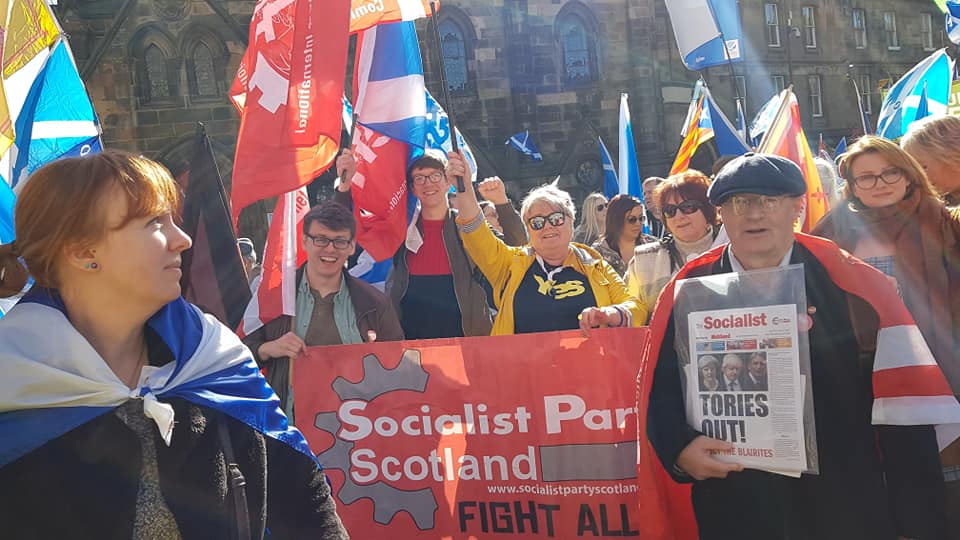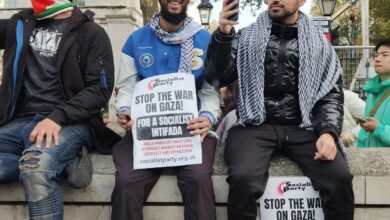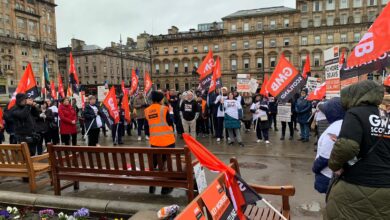Splits in the independence movement reflect deepening class divisions

By Matt Dobson
Despite support for Scottish independence being at record levels and the Scottish National Party (SNP) consistently polling at over 50%, there is rising discontent and polarisation inside the independence movement and to a lesser extent the SNP itself.
Above all this reflects different class interests, with working-class layers becoming increasingly critical of the pro-capitalist leadership of the SNP.
On November 14th the organisers of the recent mass independence mobilisations, All Under One Banner (AUOB), held an online assembly which hundreds attended.
Ian Blackford, SNP Westminster leader, was barracked by activists after putting forward no “Plan B”. An increasingly important discussion given the near certainty that the Tory Westminster government will refuse the SNP’s Plan A. ie the “democratic mandate” for indyref2 after next May’s Scottish elections.
Online consternation among independence supporters and SNP members escalated with the release of the agenda for the recent SNP national conference, held at the end of November. No fewer than 138 branch resolutions and amendments to the Sturgeon/ Blackford leadership line had been ruled out of order.
There is palpable anger over the shutting down of debate. A number of the opponents of the Sturgeon leadership were elected to various internal SNP committees at the conference. Those calling for a debate include Joanna Cherry MP (an ally of Alex Salmond who is engaged in a bitter factional battle with Sturgeon) and ‘dissident’ MP Angus MacNeil over the question of “Plan B”.
Elements close to the SNP leadership have also been accused of softening the party’s historic commitment to unilateral nuclear disarmament and backing increased UK defence spending. There is also virulent criticism by sections of the independence movement to the pro-free market Growth Commission report, commissioned by SNP leaders, on what an independent Scottish economy would resemble as well as the issues of currency.
critic
One of the most strident critics of the SNP leadership is George Kerevan, ex-SNP MP from 2015-17. Kerevan began his political career in the International Marxist Group (supporters of Ernest Mandel) in the 1970s.
In a series of articles from July –November 2020 in Conter (a left online journal), Kerevan does make penetrating points about the pro-capitalist character of the SNP leadership.
Socialist Party Scotland is in full agreement that the SNP leadership are “conservative and bureaucratic” and seeking strengthened links with big business, of which Kerevan gives many examples.
Kerevan concludes (SNP at a crossroads: What is to be done 29/9/20) that the Sturgeon “presidency” has “adapted to the political and economic needs of the upper echelons of the Scottish traditional middle class – the conservative oligarchy of lawyers, accountants, bankers” who are horrified by Johnson’s Tory governments post Brexit plans to turn the UK into an offshore tax haven.
Progress towards a “legal” second referendum must march to the beat of winning one or two or umpteen “electoral mandates” lest middle class voters take fright”. Therefore Kerevan correctly concludes “advance” in the cause for self-determination under their leadership is not possible.
Kerevan in his first Conter piece in July (SNP at a crossroads part one) starkly highlighted a “shift to the right” of the SNP under Sturgeons leadership. He cites the party’s “slavish” support of the EU (historically the SNP opposed the Common Market) which he personally clashed with Sturgeon over.
He points to the appointment of bankers and representatives of big business to author the Growth Commission report and the post-Covid recovery strategy. As well as the Scottish government’s subsidies to developers, protections of landlords and multinational agribusiness during the crisis.
Echoing points consistently made by Socialist Party Scotland, he points to the social character of SNP politicians, the total absence of manual workers as the parliamentary groups are made up of middle class professionals and business people. A top down party privileged bureaucracy has also developed financed by parliamentary expenses and massive amounts of “short money” generated by Westminster and Holyrood victories.
Kerevan pinpoints a shift to the right in 2016-2017, after the SNP had posed as “anti-austerity” amidst the surge of 90,000 new members post referendum and their 2015 landslide victory in the Westminster election. Sturgeon, in response to the Brexit result and the SNP losing 250,000 votes in the Westminster election of 2017, shut down the campaign for a second independence referendum.
The SNP leadership also then distanced themselves from the AUOB mass marches which grew up in response.
Kerevan’s analysis however gives only a partial explanation of the political direction of the SNP leadership. There are extremely important attacks he could have made, related to the class struggle in Scotland that he consciously avoids.
This feeds into the eclectic and often misguided proposals about the way forward in the struggle for democratic rights and against capitalism. In particular, Kerevan does not put forward the need for the working class to have a clear independent position from the bourgeois and middle class nationalism of the SNP.
Despite posing as anti-Tory, the SNP in government have passed on billions in cuts from Westminster over the last decade. Not just Socialist Party Scotland but local authority trade unions such as in Glasgow have called for the SNP to use the considerable financial powers of the Scottish government and councils to set legal no cuts budgets and lead a mass campaign demanding more funding for Scotland.
Of course such a struggle could be linked to a struggle for self-determination. Nowhere in his writings does Kerevan raise this. This is significant, as he was not only an SNP MP but also a Labour councillor in the 1980s during the heroic struggle of the Militant-led (forerunner of Socialist Party Scotland) Liverpool council who defeated Thatcher over funding by refusing to make cuts.
Also absent from Kerevan’s analysis are the very significant industrial disputes where trade unions have come into major conflict with the SNP. Just a few examples have included the Unite Tayside NHS porters striking over pay grading in 2015, the mass council workers 48-hour strike in Glasgow over equal pay in 2018, Sturgeons attack on the RMT guards striking against Scotrail over safety and the EIS-FELA college lecturers strikes.
This reflects Kerevan not seeing the trade unions and the organised working class as potentially playing the key role in fighting against the Tories and for democratic rights.
Covid failures
Kerevan also steers clear of the dramatic mishandling of the Covid-19 pandemic by the SNP government in 2020. Only the colossal callous behaviour of Johnson’s Tory government has masked the failures of the SNP who in the early stages were in lockstep with the Tories in abandoning mass testing and late to implement lockdown.
A refusal to adequately fund test, track and trace but also NHS and social care services, with the criminal transfers of the elderly and vulnerable from hospitals into care homes spreading the virus and increasing the death rate, means Scotland has been one of the most affected countries in Europe. Throughout the crisis, up to the time of writing, Sturgeon has refused to challenge the greedy private vultures running care homes with nationalisation and even opposed a proposal to allow care workers to collectively bargain.
Under pressure from big business, Sturgeon and Swinney did a complete u-turn in August opposing the trade unions by fully opening schools unsafely and also encouraging students back onto campuses, allowing the virus to resurge. This the root cause of the current lockdown.
The long term effects on class consciousness as the severe economic depression in Scotland worsens means the current popularity of the SNP will not last indefinitely. This class anger will be combined, as Kerevan does point out, with growing frustration with their timidity in the face of the Tories over independence. This means workers and youth need a fighting strategy based on their class interests. But does Kerevan offer this?
Can the SNP be transformed?
In his September article Kerevan says “the left (in Scotland) has retreated to being a commentator or pressure group hoping to influence the SNP leadership”. There is certainly truth in this.
Socialist Party Scotland stood almost alone in demanding the launch of a new workers’ party amidst the mass politicisation of the post-indyref autumn of 2014. Unfortunately left figures like Kerevan, but also more significantly Tommy Sheridan despite building a mass following during the campaign with a ‘socialist case for independence, tail-ended the SNP.
They refused to build a new working class party and instead urged a vote for the SNP, partly facilitating and certainly legitimising the SNP surge of tens of thousands of new members.
Of course we did not commentate from the side-lines. We made a public appeal to SNP and independence supporters to help build an anti-austerity electoral challenge with socialist policies. We put this into action by standing against the SNP, Tories and Labour with the Trade Union and Socialist Coalition (TUSC) alongside the RMT trade union.
Kerevan, who has stayed in the SNP, Sheridan and many on the left tail-ended the SNP. This has culminated in the launch of the politically amorphous “Action for Independence”, an election list which will stand in May and includes ex-SNP politicians and Tommy Sheridan. AFI calls for an SNP vote in constituencies and a vote for AFI on the regional lists.
Large parts of the pro-independence Scottish left, including Kerevan, subscribe to a two stage theory. Support the SNP until independence, which means postponing not just electoral challenges but also the class struggle against cuts-making SNP politicians. Socialism and the cause of the working class are relegated into the distant future.
Among the most confused parts of Kerevan’s analysis deal with his approach to the SNP. Despite a sizeable recruitment of working class and radicalised youth in 2014, and its new voting base in working class areas, the SNP has not been transformed into a vehicle for working-class struggle.
Kerevan, though, sees a key task for the left in effect intervening in the SNP to “defend democracy” and win an “alternative economic program”. Kerevan initially raises utilising the SNP trade union group, which on paper was bigger than Scottish Labour in 2015 with 12,000 registered supporters. But what has the SNP TU group done to intervene in the class struggle and to support workers against the SNP leadership since it was created six years ago?
Another proposal is organising supporters of the Common Weal Group, with some links to the Keynesian think tank of the same name, to try and win positions in the party structures. They have had some success with this at the recent party conference. But it is an extremely amorphous grouping and definitely not left wing far less socialist.
Kerevan himself imposes limits on this saying the current divisions over the Salmond court case show “activists support the leadership” and would not support a “faction fight”. This in itself gives insight into the actual state of the SNP internally. Despite a mass paper membership the party is dominated by the pro-capitalist bureaucracy with the majority of the 2014 surge inactive.
Kerevan actually introduces a new element to the two stage theory calling for the creation of a “New Mass Left Party” but only after independence. This he says would be based on “trade union, Labour supporters and the left of the SNP”. The SNP, and all parties in Scotland, claims Kerevan will become redundant after independence. This ignores the fact we live in a class society and capitalism cannot solve the national question.
A capitalist independent Scotland (because Kerevan postpones working class organisation for socialism until then) would lead to a sizeable section of society that would be or would become alienated from such an anti-working class entity. Only socialist policies can bring fundamental change and unite the working class.
It’s also clear that Kerevan has not learnt the lessons of the failure of the left populist formations in Europe that have a mainly middle class leadership such as Podemos in Spain, now in a capitalist government with the ex-social democracy.
He says “inside such a mass party of the left, or left Green electoral alliance, the anti-capitalist left would fight for leadership based on breaking with neo liberalism, and the market driven economy, making Scotland a democratic republic”.
Kerevan does not outline the actual program that would be needed to end capitalism in Scotland. An independent socialist Scotland, would raise an appeal to the working class internationally to fight to overthrow capitalism.
To cut across the national divisions fostered for generations by capitalism, a socialist government would fight for a voluntary democratic socialist confederation linking the working class in Scotland, England Wales and Ireland as a step towards a socialist Europe.
Rather than partial left reforms would leave the capitalists in charge of the economy, Socialist Party Scotland demands the socialist nationalisation under democratic workers’ control and management of the major corporations and banks, including a state monopoly of foreign trade and capital controls to prevent capitalist sabotage.
the struggle for independence and socialism
Kerevan illustrates that independence activists are increasingly looking away from the SNP to fight for indyref 2. After the AUOB assembly a new membership organisation has been launched, “Yes Alba”, to try and challenge the SNP leadership. This will not be under the control of the SNP leadership like the official Yes campaign in 2014.
He raises that a mass “working class united front” is needed to organise a campaign of civil disobedience, mass marches and be based in working-class housing schemes.
Socialist Party Scotland is in favour of a genuine united front in the struggle for democratic rights based on working class methods of struggle. We would, unlike Kerevan, raise the need to utilise the most powerful force in society, the organised working class and the trade union movement including in the form of general strike action, which was seen at the high point of the movement in Catalonia.
We are also clearer on the need to demand the Scottish government actually organises a referendum in defiance of the Tories. We would also call for the trade unions to co-ordinate mass action such as strikes, mass demos and occupations. We would be prepared to work with left, radical nationalists and even the SNP leadership on the key condition we have full freedom to raise our programme, including our criticisms of these forces.
Kerevan is at best unclear on this, warning against “the capture of the movement be any one tendency imposing a line that fragments the movement”. Should workers and socialists not fight for the leadership of the movement and argue for their position. Why should the trade unions and the working class not stand clearly for an independent socialist Scotland in opposition to the SNP leadership’s support for capitalism?
In reality Kerevan is supporting a popular front strategy, one where the working class holds back and retreats from its demands and seeks to build a bloc with “radical” sections of the petty bourgeois and even the capitalist class in the future.
In a Conter article Covid Capitalism: Winners and losers (11/11/20) he says “the crying need in the pandemic era is for the creation of a new, mass anti – capitalist international of workers’ parties, trade unions and peasant organisations. I am not talking about some modest re-assemblement of the far left”.
Of course the Committee for a Workers’ International (CWI) to which Socialist Party Scotland is affiliated is prepared to engage in discussion with all genuine revolutionaries around unity to build towards this.
But once Kerevan goes into detail, it’s clear he is not willing to deal with the lessons of the failure of previous mass workers’ internationals, only raising the need for an “organising centre” with no clarification around what kind of political programme such an international should be organised around.
The Second International (which Kerevan actually raises as a model framework) degenerated into national chauvinism with the outbreak of World War One in 1914. The leaders of the German SPD, the Labour leaders in Britain etc backed the war. Their counter-revolutionary position bears much responsibility for the defeat of the German Revolution and the eventual rise of fascism.
Kerevan falsely holds up the Second International which apparently “left significant latitude for ideological differences”, saying nothing about its leaders embracing of imperialist interests and their entrenched opposition to Bolshevism internationally after the Russian Revolution.
Of course a genuine Marxist workers international would carry out the maximum discussion and debate in its structures unlike the Third International’s degeneration into Stalinism.
But this would also be with the aim of reaching programmatic clarity and effective unity in action. Kerevan has not absorbed the lessons of his participation in the organisation led by Mandel which led to the degeneration after Trotsky’s death of the Fourth International.
That organisation (now the USFI, to whose journal International Viewpoint, Kerevan contributes) became a federated opportunist organisation that turned away, in the 1950s and 60s, from a consistent orientation to the organised working class, seeing the “detonators of revolution” in other social layers, such as students and the peasantry.
This led to Mandel and his organisation facing the wrong way when the mass general strike broke out in France in 1968.
Kerevan’s points about the depth and scale of the capitalist crisis and the likelihood of increased radicalisation in Scotland and internationally are accurate. However workers and the new young generation will need a clearer programme than Kerevan’s eclecticism.
The need for the complete independence of working-class organisation and programme in the struggle for democratic rights, self-determination and socialism is paramount.



